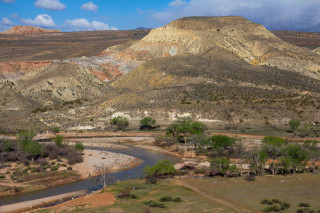Explorer Corps Marker: Washington County
Find the Marker
The Washington County marker is near the northeast corner of the sign pavilion on the north side of Confluence Park on 900 N off of N State Street in La Verkin. Confluence Park has been part of human history for more than a millennium.
GPS 37°12’35.8956”N 113°17’1.554”W
Dig Deeper
Historic threads run throughout Utah. The stories of Native Americans, European colonists, Mormon settlers, and more wind through the state. And in some places, like the appropriately-named Confluence Park, those lines come together.
Confluence Park got its name as it’s the meeting place of three creeks, including the Virgin River, and it’s been part of human history for over a millennium. More than one thousand years ago, people belonging to the Virgin Anasazi culture lived here. It was a good spot for the people who inhabited a rock shelter in the area. In addition to an enduring source of water, the area was full of wildlife and had soil that could be farmed. The same natural perks later brought the southern Paiute to the area, too, where they irrigated small fields of corn.

That corn continued to grow through the years, and that caught the attention of one of the first European colonists that visited the area. On October 15th, 1776, Spain’s Dominquez-Escalante Expedition stopped in what’s now Confluence Park. The priests were hoping to find a route from Santa Fe, New Mexico to Monterey, California, and during their stop in what’s now Utah they found large ears of corn placed on a mat and small fields of corn still growing there.
The area had not been abandoned, though. Native Americans continued to cultivate corn and other crops like beans and potatoes in these area. When Mormon settlers eventually scouted the area, they found Native Americans continuing to cultivate the land and make the most of this well-watered spot.
Archaeologists still study the clues about who lived in this place and what life was like here before the arrival of the explorers and settlers. The fact that the Dominquez-Escalante Expedition found corn, for example, not only indicates what people were growing, but helps highlight cultural connections between the Virgin Anasazi and the southern Paiute. Likewise, painted pottery matching the styles of the Fremont people have been found in the park, helping archaeologists to understand the connections between different Fremont sites in the area.
If you visit Confluence Park today, however, you won’t find fields being tended. The 344 acres of the park is a nature preserve, home to many animals and plants native to Utah. Foxes, skunks, tortoises, Gila monsters, rattlesnakes, owls, hawks, and sparrows abound here, as well as cottonwood, yucca, sagebrush, paintbrush, lily, and cactus. Several trails run through the park, as well, offering a chance to gaze upon the rivers and consider how many streams – both literal and historic – come together here.
Want to Go Farther?
Explore the park, which is still a popular place for recreation. The Confluence Trail is a great place to start, running for four miles through the park.